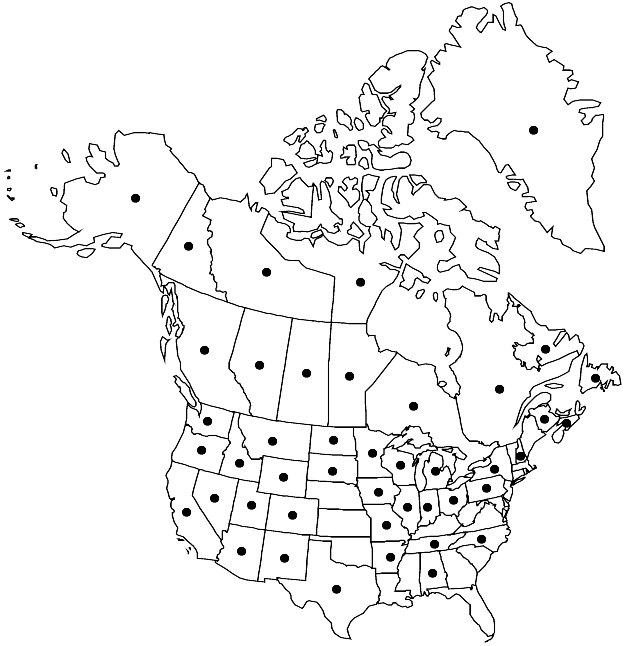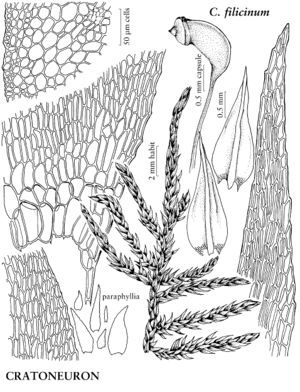Difference between revisions of "Cratoneuron filicinum"
Cat. Musc., 21. 1867.
FNA>Volume Importer |
FNA>Volume Importer |
||
| Line 18: | Line 18: | ||
|name=Amblystegium tenax var. spinifolium | |name=Amblystegium tenax var. spinifolium | ||
|authority=(Schimper) H. A. Crum & L. E. Anderson | |authority=(Schimper) H. A. Crum & L. E. Anderson | ||
| − | }}{{Treatment/ID/Synonym | + | }} {{Treatment/ID/Synonym |
|name=Cratoneuron filicinum var. aciculinum | |name=Cratoneuron filicinum var. aciculinum | ||
|authority=(Müller Hal. & Kindberg) Grout | |authority=(Müller Hal. & Kindberg) Grout | ||
| Line 35: | Line 35: | ||
|elevation=low to high elevations | |elevation=low to high elevations | ||
|distribution=Greenland;Alta.;B.C.;Man.;N.B.;Nfld. and Labr.;N.W.T.;N.S.;Nunavut;Ont.;Que.;Sask.;Yukon;Ala.;Alaska;Ariz.;Ark.;Calif.;Colo.;Idaho;Ill.;Ind.;Iowa;Mich.;Minn.;Mo.;Mont.;Nev.;N.H.;N.Mex.;N.Y.;N.C.;N.Dak.;Ohio;Oreg.;Pa.;S.Dak.;Tenn.;Tex.;Utah;Wash.;Wis.;Wyo.;Mexico (Baja California;México;Oaxaca;San Luis Potosí);South America;Eurasia;Africa;Atlantic Islands;Pacific Islands (New Zealand). | |distribution=Greenland;Alta.;B.C.;Man.;N.B.;Nfld. and Labr.;N.W.T.;N.S.;Nunavut;Ont.;Que.;Sask.;Yukon;Ala.;Alaska;Ariz.;Ark.;Calif.;Colo.;Idaho;Ill.;Ind.;Iowa;Mich.;Minn.;Mo.;Mont.;Nev.;N.H.;N.Mex.;N.Y.;N.C.;N.Dak.;Ohio;Oreg.;Pa.;S.Dak.;Tenn.;Tex.;Utah;Wash.;Wis.;Wyo.;Mexico (Baja California;México;Oaxaca;San Luis Potosí);South America;Eurasia;Africa;Atlantic Islands;Pacific Islands (New Zealand). | ||
| − | |discussion=<p>Strikingly rigid plants of Cratoneuron filicinum with extremely strong, often long-excurrent costae are sometimes found in streams or under heavily dripping water; these were sometimes recognized as Amblystegium tenax var. spinifolium in North America. Such plants have narrowly triangular or narrowly ovate-triangular leaves gradually narrowed to an acuminate or often obtuse point. Ordinary C. filicinum leaves are sometimes found in parts of such plants, or shoots on old plants of this kind may have a normal C. filicinum appearance. Molecular studies show that such plants likely represent habitat modifications and should therefore not be recognized taxonomically (L. Hedenäs 2011, 2012). Cratoneuron curvicaule (Juratzka) G. Roth was attributed to North America by H. A. Crum et al. (1973) as C. filicinum var. curvicaule (Juratzka) Mönkemeyer; the species has been considered a synonym of C. filicinum on several American web pages. However, as shown by Hedenäs (2003, 2011), this is a distinct species that differs both morphologically and molecularly from C. filicinum. The occurrence of C. curvicaule in North America has not been confirmed, and the only North American specimens referred to this species (H. G. Simmons 584 [in part] and 585, S) belong to C. filicinum.</p> | + | |discussion=<p>Strikingly rigid plants of <i>Cratoneuron filicinum</i> with extremely strong, often long-excurrent costae are sometimes found in streams or under heavily dripping water; these were sometimes recognized as <i>Amblystegium</i> tenax var. spinifolium in North America. Such plants have narrowly triangular or narrowly ovate-triangular leaves gradually narrowed to an acuminate or often obtuse point. Ordinary <i>C. filicinum</i> leaves are sometimes found in parts of such plants, or shoots on old plants of this kind may have a normal <i>C. filicinum</i> appearance. Molecular studies show that such plants likely represent habitat modifications and should therefore not be recognized taxonomically (L. Hedenäs 2011, 2012). <i>Cratoneuron</i> curvicaule (Juratzka) G. Roth was attributed to North America by H. A. Crum et al. (1973) as <i>C. filicinum</i> var. curvicaule (Juratzka) Mönkemeyer; the species has been considered a synonym of <i>C. filicinum</i> on several American web pages. However, as shown by Hedenäs (2003, 2011), this is a distinct species that differs both morphologically and molecularly from <i>C. filicinum</i>. The occurrence of C. curvicaule in North America has not been confirmed, and the only North American specimens referred to this species (H. G. Simmons 584 [in part] and 585, S) belong to <i>C. filicinum</i>.</p> |
|tables= | |tables= | ||
|references= | |references= | ||
| Line 58: | Line 58: | ||
|publication year=1867 | |publication year=1867 | ||
|special status=Selected by author to be illustrated | |special status=Selected by author to be illustrated | ||
| − | |source xml=https://jpend@bitbucket.org/aafc-mbb/fna-data-curation.git/src/ | + | |source xml=https://jpend@bitbucket.org/aafc-mbb/fna-data-curation.git/src/8f726806613d60c220dc4493de13607dd3150896/coarse_grained_fna_xml/V28/V28_419.xml |
|genus=Cratoneuron | |genus=Cratoneuron | ||
|species=Cratoneuron filicinum | |species=Cratoneuron filicinum | ||
Revision as of 17:05, 18 September 2019
Plants somewhat stiff. Stems with shoot and branch apices often pale; paraphyllia sometimes present only in youngest shoot portions; axillary hairs few, weak. Stem leaves gradually or suddenly narrowed to apex, plane or slightly concave; alar cells usually many, region large, usually strongly widened marginally, reaching from margin to costa or almost so; medial laminal cells 12–55 × 4–11 µm. Branch leaves usually narrower, more strongly falcate. Perichaetia with inner leaves gradually or suddenly narrowed to apex, plicate, margins denticulate or strongly so distally, apex acuminate, laminal cells smooth.
Habitat: Moist or wet habitats in calcareous districts, rock, tree bases beside streams, springs, moist soil, calcareous fens
Elevation: low to high elevations
Distribution

Greenland, Alta., B.C., Man., N.B., Nfld. and Labr., N.W.T., N.S., Nunavut, Ont., Que., Sask., Yukon, Ala., Alaska, Ariz., Ark., Calif., Colo., Idaho, Ill., Ind., Iowa, Mich., Minn., Mo., Mont., Nev., N.H., N.Mex., N.Y., N.C., N.Dak., Ohio, Oreg., Pa., S.Dak., Tenn., Tex., Utah, Wash., Wis., Wyo., Mexico (Baja California, México, Oaxaca, San Luis Potosí), South America, Eurasia, Africa, Atlantic Islands, Pacific Islands (New Zealand).
Discussion
Strikingly rigid plants of Cratoneuron filicinum with extremely strong, often long-excurrent costae are sometimes found in streams or under heavily dripping water; these were sometimes recognized as Amblystegium tenax var. spinifolium in North America. Such plants have narrowly triangular or narrowly ovate-triangular leaves gradually narrowed to an acuminate or often obtuse point. Ordinary C. filicinum leaves are sometimes found in parts of such plants, or shoots on old plants of this kind may have a normal C. filicinum appearance. Molecular studies show that such plants likely represent habitat modifications and should therefore not be recognized taxonomically (L. Hedenäs 2011, 2012). Cratoneuron curvicaule (Juratzka) G. Roth was attributed to North America by H. A. Crum et al. (1973) as C. filicinum var. curvicaule (Juratzka) Mönkemeyer; the species has been considered a synonym of C. filicinum on several American web pages. However, as shown by Hedenäs (2003, 2011), this is a distinct species that differs both morphologically and molecularly from C. filicinum. The occurrence of C. curvicaule in North America has not been confirmed, and the only North American specimens referred to this species (H. G. Simmons 584 [in part] and 585, S) belong to C. filicinum.
Selected References
None.
